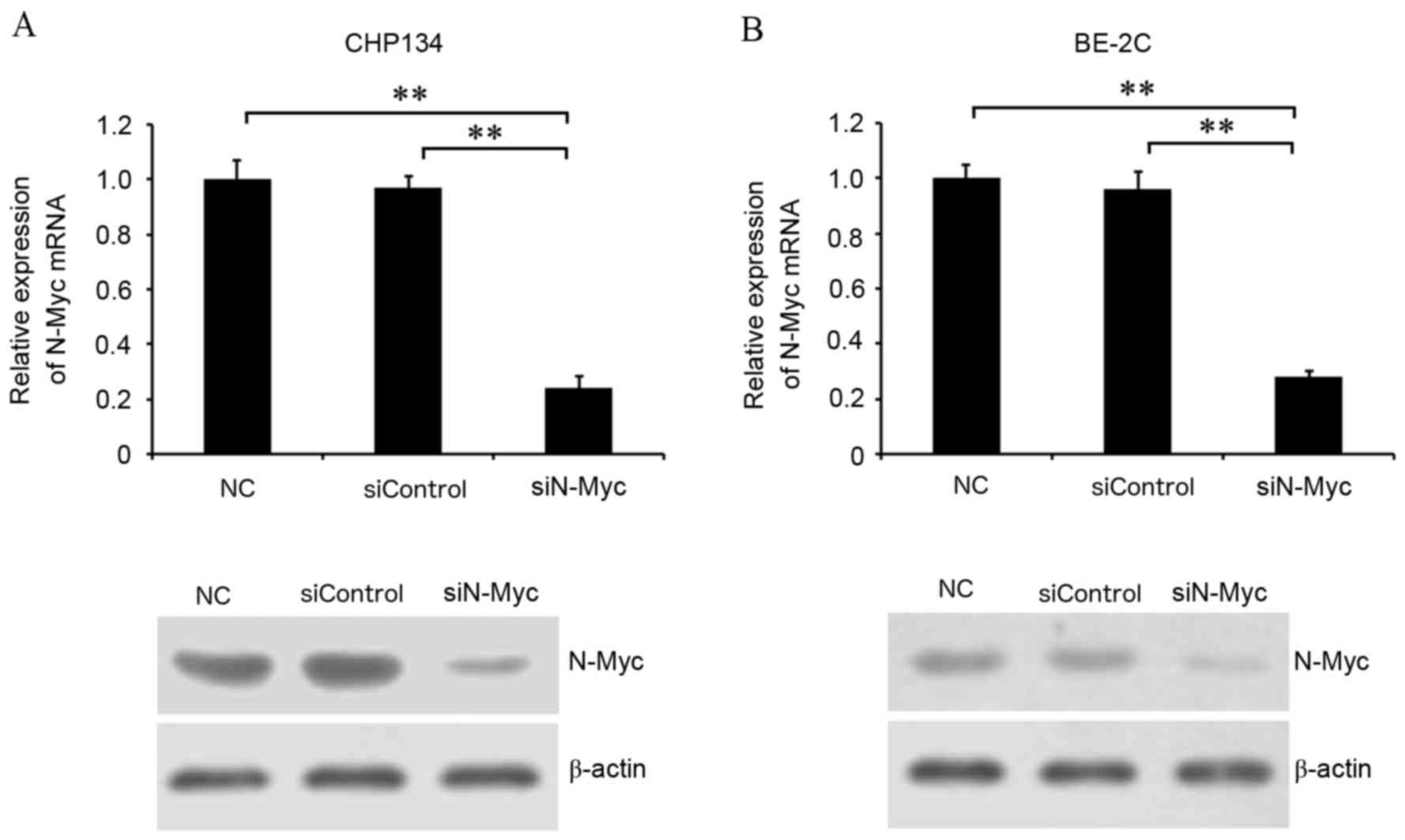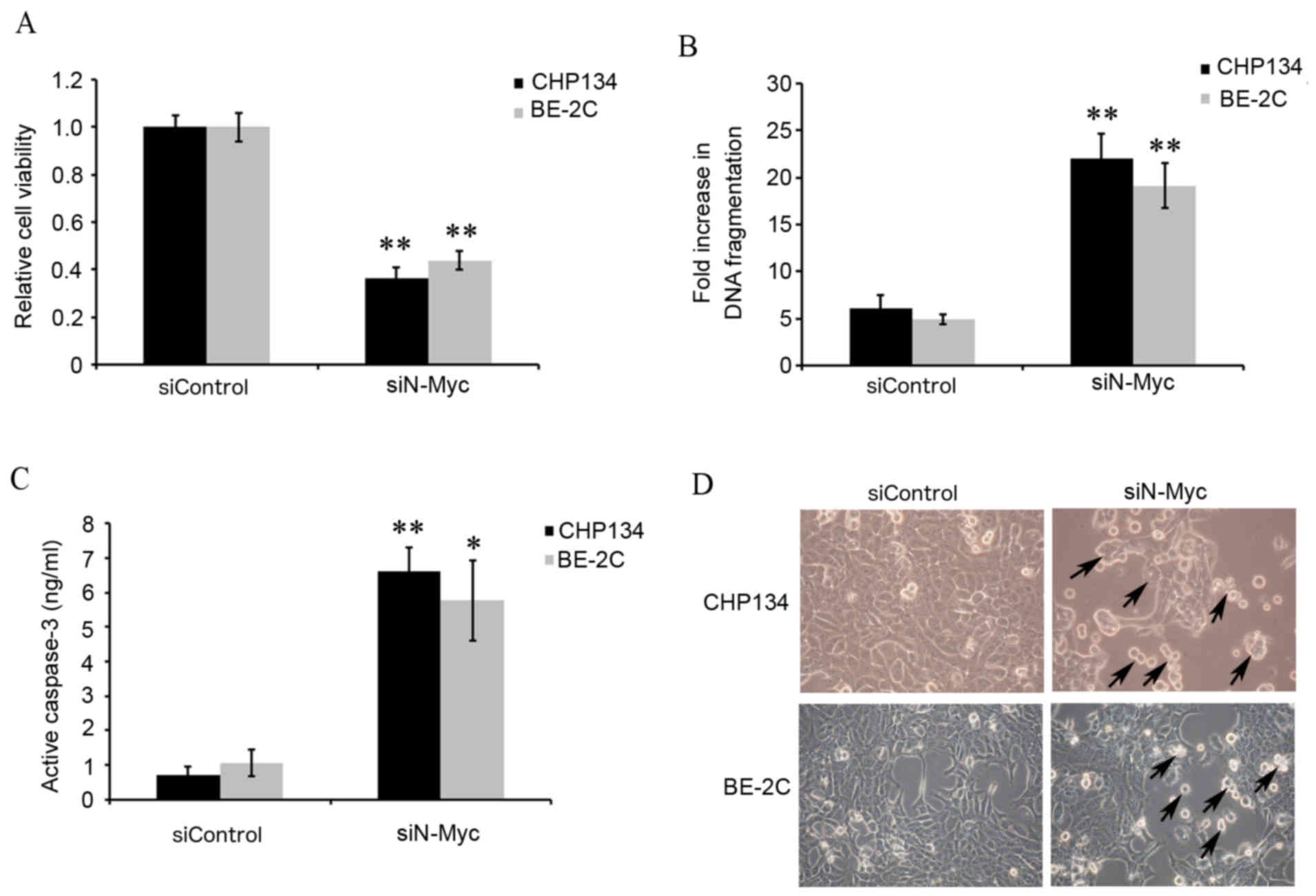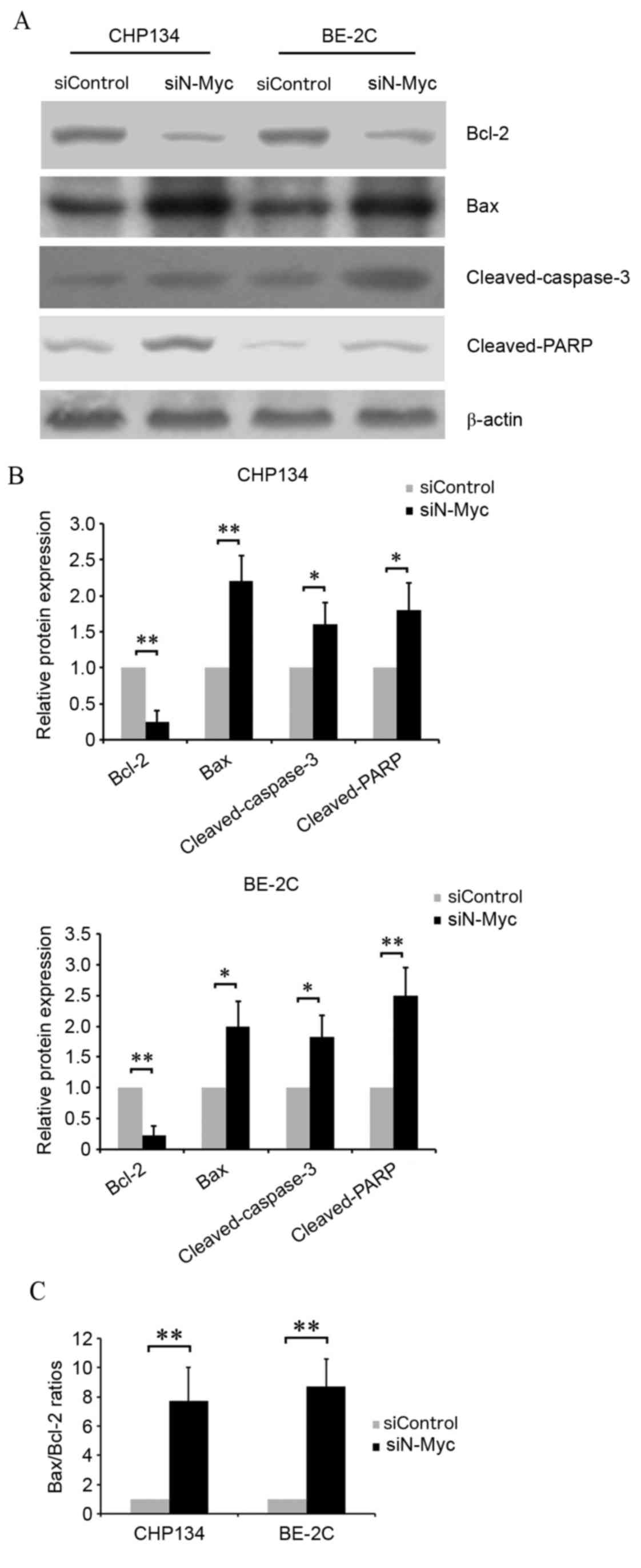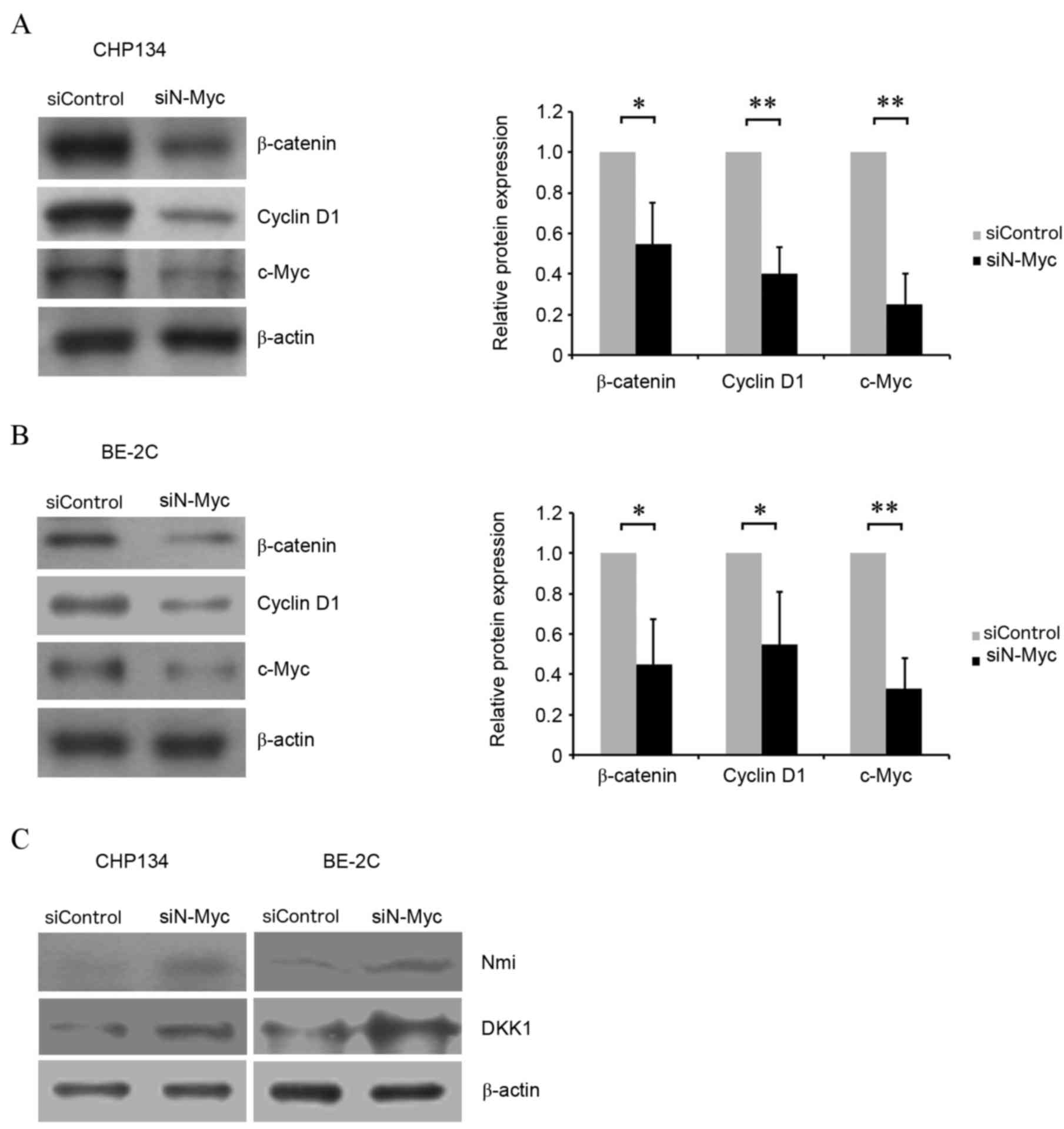|
1
|
Lanzkowsky P: Chapter
22-NeuroblastomaManual of Pediatric Hematology and Oncology. 5th
edition. Academic Press; pp. 671–694. 2011, View Article : Google Scholar
|
|
2
|
John J and Gregory Jr: Neuroblastoma:
Pediatric Cancers: Merck Manual Professional. Retrieved. Apr
17–2008.
|
|
3
|
Maris JM, Hogarty MD, Bagatell R and Cohn
SL: Neuroblastoma. Lancet. 369:2106–2120. 2007. View Article : Google Scholar : PubMed/NCBI
|
|
4
|
Brodeur GM, Hogarty MD, Mosse YP and Maris
JM: NeuroblastomaPizzo PA, Adamson PC and Poplack DG: Principles
and Practice of Pediatric Oncology. 6th edition. Philadelphia, PA:
Wolters Kluwer Health/Lippincott Williams & Wilkins; pp.
886–922. 2011
|
|
5
|
Logan CY and Nusse R: The Wnt signaling
pathway in development and disease. Annu Rev Cell Dev Biol.
20:781–810. 2004. View Article : Google Scholar : PubMed/NCBI
|
|
6
|
Clevers H: Wnt/beta-catenin signaling in
development and disease. Cell. 127:469–480. 2006. View Article : Google Scholar : PubMed/NCBI
|
|
7
|
Klaus A and Birchmeier W: Wnt signalling
and its impact on development and cancer. Nat Rev Cancer.
8:387–398. 2008. View
Article : Google Scholar : PubMed/NCBI
|
|
8
|
He TC, Sparks AB, Rago C, Hermeking H,
Zawel L, da Costa LT, Morin PJ, Vogelstein B and Kinzler KW:
Identification of c-MYC as a target of the APC pathway. Science.
281:1509–1512. 1998. View Article : Google Scholar : PubMed/NCBI
|
|
9
|
Tetsu O and McCormick F: Beta-catenin
regulates expression of cyclin D1 in colon carcinoma cells. Nature.
398:422–426. 1999. View
Article : Google Scholar : PubMed/NCBI
|
|
10
|
Liu C, Tu Y, Sun X, Jiang J, Jin X, Bo X,
Li Z, Bian A, Wang X, Liu D, et al: Wnt/beta-Catenin pathway in
human glioma: Expression pattern and clinical/prognostic
correlations. Clin Exp Med. 11:105–12. 2011. View Article : Google Scholar : PubMed/NCBI
|
|
11
|
Liu X, Wang L, Zhao S, Ji X, Luo Y and
Ling F: beta-Catenin overexpression in malignant glioma and its
role in proliferation and apoptosis in glioblastma cells. Med
Oncol. 28:608–614. 2011. View Article : Google Scholar : PubMed/NCBI
|
|
12
|
Pu P, Zhang Z, Kang C, Jiang R, Jia Z,
Wang G and Jiang H: Downregulation of Wnt2 and beta-catenin by
siRNA suppresses malignant glioma cell growth. Cancer Gene Ther.
16:351–561. 2009. View Article : Google Scholar : PubMed/NCBI
|
|
13
|
Sareddy GR, Panigrahi M, Challa S,
Mahadevan A and Babu PP: Activation of Wnt/beta-catenin/Tcf
signaling pathway in human astrocytomas. Neurochem Int. 55:307–317.
2009. View Article : Google Scholar : PubMed/NCBI
|
|
14
|
Utsuki S, Sato Y, Oka H, Tsuchiya B,
Suzuki S and Fujii K: Relationship between the expression of E-,
N-cadherins and beta-catenin and tumor grade in astrocytomas. J
Neurooncol. 57:187–192. 2002. View Article : Google Scholar : PubMed/NCBI
|
|
15
|
Rossi M, Magnoni L, Miracco C, Mori E,
Tosi P, Pirtoli L, Tini P, Oliveri G, Cosci E and Bakker A:
β-catenin and Gli1 are prognostic markers in glioblastoma. Cancer
Biol Ther. 11:753–761. 2011. View Article : Google Scholar : PubMed/NCBI
|
|
16
|
Knoepfler PS, Cheng PF and Eisenman RN:
N-myc is essential during neurogenesis for the rapid expansion of
progenitor cell populations and the inhibition of neuronal
differentiation. Genes Dev. 16:2699–2712. 2002. View Article : Google Scholar : PubMed/NCBI
|
|
17
|
Mueller S and Matthay KK: Neuroblastoma:
Biology and staging. Curr Oncol Rep. 11:431–438. 2009. View Article : Google Scholar : PubMed/NCBI
|
|
18
|
Huang M and Weiss WA: Neuroblastoma and
MYCN. Cold Spring Harb Perspect Med. 3:a0144152013. View Article : Google Scholar : PubMed/NCBI
|
|
19
|
Barker N and Clevers H: Mining the Wnt
pathway for cancer therapeutics. Nat Rev Drug Discov. 5:997–1014.
2006. View
Article : Google Scholar : PubMed/NCBI
|
|
20
|
Kuwahara A, Hirabayashi Y, Knoepfler PS,
Taketo MM, Sakai J, Kodama T and Gotoh Y: Wnt signaling and its
downstream target N-myc regulate basal progenitors in the
developing neocortex. Development. 137:1035–1044. 2010. View Article : Google Scholar : PubMed/NCBI
|
|
21
|
Koppen A, Ait-Aissa R, Hopman S, Koster J,
Haneveld F, Versteeg R and Valentijn LJ: Dickkopf-1 is
down-regulated by MYCN and inhibits neuroblastoma cell
proliferation. Cancer Lett. 256:218–228. 2007. View Article : Google Scholar : PubMed/NCBI
|
|
22
|
Zhou XL, Qin XR, Zhang XD and Ye LH:
Downregulation of Dickkopf-1 is responsible for high proliferation
of breast cancer cells via losing control of Wnt/beta-catenin
signaling. Acta Pharmacol Sin. 31:202–210. 2010. View Article : Google Scholar : PubMed/NCBI
|
|
23
|
Mao B, Wu W, Davidson G, Marhold J, Li M,
Mechler BM, Delius H, Hoppe D, Stannek P, Walter C, et al: Kremen
proteins are Dickkopf receptors that regulate Wnt/beta-catenin
signalling. Nature. 417:664–667. 2002. View Article : Google Scholar : PubMed/NCBI
|
|
24
|
Bell E, Premkumar R, Carr J, Lu X, Lovat
PE, Kees UR, Lunec J and Tweddle DA: The role of MYCN in the
failure of MYCN amplified neuroblastoma cell lines to G1 arrest
after DNA damage. Cell Cycle. 5:2639–2647. 2006. View Article : Google Scholar : PubMed/NCBI
|
|
25
|
Livak KJ and Schmittgen TD: Analysis of
relative gene expression data using real-time quantitative PCR and
the 2(-Delta Delta C(T)) method. Methods. 25:402–408. 2001.
View Article : Google Scholar : PubMed/NCBI
|
|
26
|
Salvesen GS: Caspases: Opening the boxes
and interpreting the arrows. Cell Death Differ. 9:3–5. 2002.
View Article : Google Scholar : PubMed/NCBI
|
|
27
|
Ghavami S, Hashemi M, Ande SR, Yeganeh B,
Xiao W, Eshraghi M, Bus CJ, Kadkhoda K, Wiechec E, Halayko AJ and
Los M: Apoptosis and cancer: Mutations within caspase genes. J Med
Genet. 46:497–510. 2009. View Article : Google Scholar : PubMed/NCBI
|
|
28
|
Maris JM: Recent advances in
neuroblastoma. N Engl J Med. 362:2202–2211. 2010. View Article : Google Scholar : PubMed/NCBI
|
|
29
|
MYCN v-myc myelocytomatosis viral related
oncogene, neuroblastoma derived [Mus musculus (house mouse)]. Gene
ID: 18109. https://www.ncbi.nlm.nih.gov/gene/18109Updated.
Apr 8–2018.
|
|
30
|
Song Y, Oda Y, Hori M, Kuroiwa K, Ono M,
Hosoi F, Basaki Y, Tokunaga S, Kuwano M, Naito S and Tsuneyoshi M:
N-myc downstream regulated gene-1/Cap43 may play an important role
in malignant progression ofprostate cancer, in its close
association with E-cadherin. Hum Pathol. 41:214–222. 2010.
View Article : Google Scholar : PubMed/NCBI
|
|
31
|
Song Y, Lv L, Du J, Yue L and Cao L:
Correlation of N-mycdownstream-regulated gene 1 subcellular
localization and lymph node metastases ofcolorectal neoplasms.
Biochem Biophys Res Commun. 439:241–246. 2013. View Article : Google Scholar : PubMed/NCBI
|
|
32
|
Saksela K, Bergh J and Nilsson K:
Amplification of the N-myconcogene in an adenocarcinoma of the
lung. J Cell Biochem. 31:297–304. 1986. View Article : Google Scholar : PubMed/NCBI
|
|
33
|
Nau MM, Carney DN, Battey J, Johnson B,
Little C, Gazdar A and Minna JD: Amplification, expression and
rearrangement of c-myc and N-myconcogenes in human lung cancer.
Curr Top Microbiol Immunol. 113:172–177. 1984.PubMed/NCBI
|
|
34
|
Metge BJ, Mitra A, Chen D, Shevde LA and
Samant RS: N-Mycand STAT Interactor regulates autophagy and
chemosensitivity in breast cancer cells. Sci Rep. 5:119952015.
View Article : Google Scholar : PubMed/NCBI
|
|
35
|
Brodeur GM, Seeger RC, Schwab M, Varmus HE
and Bishop JM: Amplification of N-mycin untreated human
neuroblastomas correlates with advanced disease stage. Science.
224:1121–1124. 1984. View Article : Google Scholar : PubMed/NCBI
|
|
36
|
Schwab M, Ellison J, Busch M, Rosenau W,
Varmus HE and Bishop JM: Enhanced expression of the human gene
N-mycconsequent to amplification of DNA may contribute to malignant
progression of neuroblastoma. Proc Natl Acad Sci USA. 81:4940–4944.
1984. View Article : Google Scholar : PubMed/NCBI
|
|
37
|
Lopez J and Tait SW: Mitochondrial
apoptosis: Killing cancer using the enemy within. Br J Cancer.
112:957–962. 2015. View Article : Google Scholar : PubMed/NCBI
|
|
38
|
Cohen GM: Caspases: The executioners of
apoptosis. Biochem J. 326:1–16. 1997. View Article : Google Scholar : PubMed/NCBI
|
|
39
|
Sun H, Gao Y, Lu K, Zhao G, Li X, Li Z and
Chang H: Overexpression of Klotho suppresses liver cancer
progression and induces cell apoptosis by negatively regulating
wnt/β-catenin signaling pathway. World J Surg Oncol. 13:3072015.
View Article : Google Scholar : PubMed/NCBI
|
|
40
|
Vieira GC, Chockalingam S, Melegh Z,
Greenhough A, Malik S, Szemes M, Park JH, Kaidi A, Zhou L,
Catchpoole D, et al: LGR5 regulates pro-survival MEK/ERK and
proliferative Wnt/β-catenin signalling in neuroblastoma.
Oncotarget. 6:40053–40067. 2015. View Article : Google Scholar : PubMed/NCBI
|
|
41
|
Damalas A, Ben-Ze'ev A, Simcha I, Shtutman
M, Leal JF, Zhurinsky J, Geiger B and Oren M: Excess beta-catenin
promotes accumulation of transcriptionally active p53. EMBO J.
18:3054–3063. 1999. View Article : Google Scholar : PubMed/NCBI
|
|
42
|
Shu W, Guttentag S, Wang Z, Andl T,
Ballard P, Lu MM, Piccolo S, Birchmeier W, Whitsett JA, Millar SE
and Morrisey EE: Wnt/beta-catenin signaling acts upstream of N-myc,
BMP4, and FGF signaling to regulate proximal-distal patterning in
the lung. Dev Biol. 283:226–239. 2005. View Article : Google Scholar : PubMed/NCBI
|
|
43
|
Mao B and Nichrs C: Kremen2 modulates
Dickkopf2 activity during Wnt/LRP6 signaling. Gene. 302:179–183.
2003. View Article : Google Scholar : PubMed/NCBI
|
|
44
|
Liu W, Xing F, Iiizumi-Gairani M, Okuda H,
Watabe M, Pai SK, Pandey PR, Hirota S, Kobayashi A, Mo YY, et al:
N-myc downstream regulated gene 1 modulates Wnt-β-catenin
signalling and pleiotropically suppresses metastasis. EMBO Mol Med.
4:93–108. 2012. View Article : Google Scholar : PubMed/NCBI
|
|
45
|
Fillmore RA, Mitra A, Xi Y, Ju J, Scammell
J, Shevde LA and Samant RS: Nmi (N-Myc interactor) inhibits
Wnt/beta-catenin signaling and retards tumor growth. Int J Cancer.
125:556–564. 2009. View Article : Google Scholar : PubMed/NCBI
|
|
46
|
Bannasch D, Weis I and Schwab M: Nmi
protein interacts with regions that differ between MycN and Myc and
is localized in the cytoplasm of neuroblastoma cells in contrast to
nuclear MycN. Oncogene. 18:6810–6817. 1999. View Article : Google Scholar : PubMed/NCBI
|


















